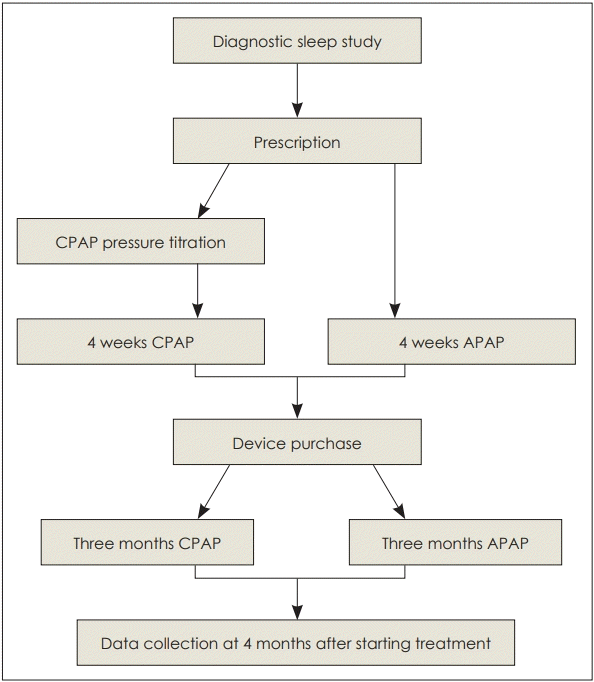1. Partinen M, Guilleminault C. Daytime sleepiness and vascular morbidity at seven-year follow-up in obstructive sleep apnea patients. Chest. 1990; 97(1):27–32.

2. Kales A, Caldwell AB, Cadieux RJ, Vela-Bueno A, Ruch LG, Mayes SD. Severe obstructive sleep apnea--II: Associated psychopathology and psychosocial consequences. J Chronic Dis. 1985; 38(5):427–34.

3. Kim HY, Jang MS. Improving compliance for continuous positive airway pressure compliance and possible influencing factors. Korean J Otorhinolaryngol-Head and Neck Surg. 2014; 57(1):7–14.

4. Nieto FJ, Young TB, Lind BK, Shahar E, Samet JM, Redline S, et al. Association of sleep-disordered breathing, sleep apnea, and hypertension in a large community-based study. Sleep Heart Health Study. JAMA. 2000; 283(14):1829–36.
5. Kim J, In K, Kim J, You S, Kang K, Shim J, et al. Prevalence of sleep-disordered breathing in middle-aged Korean men and women. Am J Respir Crit Care Med. 2004; 170(10):1108–13.

6. Sullivan CE, Issa FG, Berthon-Jones M, Eves L. Reversal of obstructive sleep apnoea by continuous positive airway pressure applied through the nares. Lancet. 1981; 1(8225):862–5.

7. Parish JM, Lyng PJ. Quality of life in bed partners of patients with obstructive sleep apnea or hypopnea after treatment with continuous positive airway pressure. Chest. 2003; 124(3):942–7.

8. Engleman HM, Martin SE, Deary IJ, Douglas NJ. Effect of CPAP therapy on daytime function in patients with mild sleep apnoea/hypopnoea syndrome. Thorax. 1997; 52(2):114–9.

9. Loube DI, Gay PC, Strohl KP, Pack AI, White DP, Collop NA. Indications for positive airway pressure treatment of adult obstructive sleep apnea patients: A consensus statement. Chest. 1999; 115(3):863–6.
10. Hoffstein V. Review of oral appliances for treatment of sleep-disordered breathing. Sleep Breath. 2007; 11(1):1–22.

11. Weaver TE, Maislin G, Dinges DF, Younger J, Cantor C, McCloskey S, et al. Self-efficacy in sleep apnea: Instrument development and patient perceptions of obstructive sleep apnea risk, treatment benefit, and volition to use continuous positive airway pressure. Sleep. 2003; 26(6):727–32.

12. Vital FM, Saconato H, Ladeira MT, Sen A, Hawkes CA, Soares B, et al. Non-invasive positive pressure ventilation (CPAP or bilevel NPPV) for cardiogenic pulmonary edema. Cochrane Database Syst Rev. 2008; (3):CD005351.

13. Sin DD, Mayers I, Man GC, Pawluk L. Long-term compliance rates to continuous positive airway pressure in obstructive sleep apnea: A population-based study. Chest. 2002; 121(2):430–5.
14. Nowak C, Bourgin P, Portier F, Genty E, Escourrou P, Bobin S. [Nasal obstruction and compliance to nasal positive airway pressure]. Ann Otolaryngol Chir Cervicofac. 2003; 120(3):161–6.
15. Han EK, Yoon IY, Chung S. The compliance and effect of CPAP in obstructive sleep apnea syndrome. Sleep Med Psychophysiol. 2006; 13(2):52–8.
16. Berkani M, Lofaso F, Chouaid C, Pia d’Ortho M, Theret D, Grillier-Lanoir V, et al. CPAP titration by an auto-CPAP device based on snoring detection: A clinical trial and economic considerations. Eur Respir J. 1998; 12(4):759–63.

17. Berry RB, Parish JM, Hartse KM. The use of auto-titrating continuous positive airway pressure for treatment of adult obstructive sleep apnea. An American Academy of Sleep Medicine review. Sleep. 2002; 25(2):148–73.
18. d’Ortho MP. Auto-titrating continuous positive airway pressure for treating adult patients with sleep apnea syndrome. Curr Opin Pulm Med. 2004; 10(6):495–9.

19. Randerath WJ, Galetke W, David M, Siebrecht H, Sanner B, Rühle K. Prospective randomized comparison of impedance-controlled autocontinuous positive airway pressure (APAP(FOT)) with constant CPAP. Sleep Med. 2001; 2(2):115–24.

20. Kribbs NB, Pack AI, Kline LR, Smith PL, Schwartz AR, Schubert NM, et al. Objective measurement of patterns of nasal CPAP use by patients with obstructive sleep apnea. Am Rev Respir Dis. 1993; 147(4):887–95.

21. Teschler H, Berthon-Jones M. Intelligent CPAP systems: Clinical experience. Thorax. 1998; 53 Suppl 3:S49–54.

22. Basner RC. Cardiovascular morbidity and obstructive sleep apnea. N Engl J Med. 2007; 356(17):1751–8.

23. Dhillon S, Chung SA, Fargher T, Huterer N, Shapiro CM. Sleep apnea, hypertension, and the effects of continuous positive airway pressure. Am J Hypertens. 2005; 18(5 Pt 1):594–600.

24. Aloia MS, Stanchina M, Arnedt JT, Malhotra A, Millman RP. Treatment adherence and outcomes in flexible vs standard continuous positive airway pressure therapy. Chest. 2005; 127(6):2085–93.

25. Kushida CA, Littner MR, Morgenthaler T, Alessi CA, Bailey D, Coleman J Jr, et al. Practice parameters for the indications for polysomnography and related procedures: An update for 2005. Sleep. 2005; 28(4):499–521.

26. Parish JM, Miller BW, Hentz JG. Autotitration positive airway pressure therapy in patients with obstructive sleep apnea who are intolerant of fixed continuous positive airway pressure. Sleep Breath. 2008; 12(3):235–41.

27. Valentin A, Subramanian S, Quan SF, Berry RB, Parthasarathy S. Air leak is associated with poor adherence to autoPAP therapy. Sleep. 2011; 34(6):801–6.

28. Lebret M, Arnol N, Martinot JB, Lambert L, Tamisier R, Pepin JL, et al. Determinants of Unintentional Leaks During CPAP Treatment in OSA. Chest. 2018; 153(4):834–42.

29. Genta PR, Lorenzi-Filho G. Sealing the leak: A step forward in improving CPAP adherence. Chest. 2018; 153(4):774–5.
30. Woehrle H, Arzt M, Graml A, Fietze I, Young P, Teschler H, et al. Effect of a patient engagement tool on positive airway pressure adherence: Analysis of a German healthcare provider database. Sleep Med. 2018; 41:20–6.






 Citation
Citation Print
Print



 XML Download
XML Download